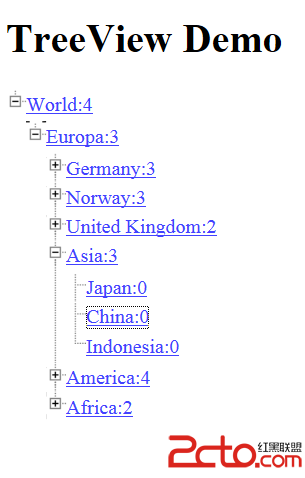Maison >développement back-end >tutoriel php >Cadre de développement PHP Tutoriel Yii Framework (19) Exemple de composant d'interface utilisateur TreeView
Cadre de développement PHP Tutoriel Yii Framework (19) Exemple de composant d'interface utilisateur TreeView
- 黄舟original
- 2017-01-21 10:31:001221parcourir
CTreeView est utilisé pour afficher des données hiérarchiques, en utilisant TreeView en définissant la propriété Data. Data est un tableau avec la structure suivante :
ext : string, le texte du nœud de l'arborescence.
expansé : booléen, facultatif, indiquant si le nœud est développé.
id : chaîne, facultatif, l'ID du nœud.
hasChildren : booléen, facultatif, la valeur par défaut est False, lorsque True, cela signifie que le nœud contient des nœuds enfants.
children : tableau, facultatif, tableau de nœuds enfants.
htmlOptions : tableau, options HTML.
Jusqu'à présent nous n'avons pas introduit la lecture de la base de données, donc les données utilisant Hard Code dans cet exemple sont les suivantes :
array( 'text' => ' 'id' => '27' , 'hasChildren' => true, 'children' => array ( array( 'text' => ' 'id' => '1' , 'hasChildren' => true, 'children' => array ( array( 'text' => ' 'id' => '3' , 'hasChildren' => true, 'children' => array ( array( 'text' => ' 'id' => '15' , 'hasChildren' => false, ), array( 'text' => ' 'id' => '16' , 'hasChildren' => false, ), array( 'text' => ' 'id' => '5' , 'hasChildren' => false, ) )), array( 'text' => ' 'id' => '2' , 'hasChildren' => true, 'children' => array ( array( 'text' => ' 'id' => '10' , 'hasChildren' => false, ), array( 'text' => ' 'id' => '12' , 'hasChildren' => false, ), array( 'text' => ' 'id' => '11' , 'hasChildren' => false, ))), array( 'text' => ' 'id' => '4' , 'hasChildren' => true, 'children' => array( array( 'text' => ' 'id' => '13' , 'hasChildren' => false, ), array( 'text' => ' 'id' => '14' , 'hasChildren' => false, ))), array( 'text' => ' 'id' => '7' , 'hasChildren' => true, 'children' => array ( array( 'text' => ' 'id' => '18' , 'hasChildren' => false, ), array( 'text' => ' 'id' => '20' , 'hasChildren' => false, ), array( 'text' => ' 'id' => '19' , 'hasChildren' => false, ) )), array( 'text' => ' 'id' => '9' , 'hasChildren' => true, 'children' => array ( array( 'text' => ' 'id' => '23' , 'hasChildren' => false, ), array( 'text' => ' 'id' => '24' , 'hasChildren' => false, ), array( 'text' => ' 'id' => '25' , 'hasChildren' => false, ), array( 'text' => ' 'id' => '26' , 'hasChildren' => false, ))), array( 'text' => ' 'id' => '8' , 'hasChildren' => true, 'children' => array( array( 'text' => ' 'id' => '22' , 'hasChildren' => false, ), array( 'text' => ' 'id' => '21' , 'hasChildren' => false ) ) ) )))));
Ici un lien est ajouté au texte de chaque nœud, et en même temps, il démontre également l'utilisation de JQuery pour répondre aux événements de clic sur les nœuds, ce qui est réalisé via des JavaScripts côté client.
Modifier la définition de la vue
$cs=Yii::app()->clientScript;
$cs->registerScript('menuTreeClick', "
jQuery('#menu-treeview a').click(function() {
alert('Node #'+this.id+' was clicked!');
return false;
});
");
$this->widget('CTreeView',array(
'id'=>'menu-treeview',
'data'=>DataModel::getDummyData(),
'control'=>'#treecontrol',
'animated'=>'fast',
'collapsed'=>true,
'htmlOptions'=>array(
'class'=>'filetree'
)
));
?>Le registerScript de clientScript est utilisé pour définir les JavaScript côté client.

Ce qui précède est le contenu du tutoriel du framework de développement PHP Yii Framework (19) Exemple TreeView du composant d'interface utilisateur Pour plus de contenu connexe, veuillez faire attention au site Web PHP chinois (. www.php.cn) !
Articles Liés
Voir plus- Comment utiliser cURL pour implémenter les requêtes Get et Post en PHP
- Comment utiliser cURL pour implémenter les requêtes Get et Post en PHP
- Comment utiliser cURL pour implémenter les requêtes Get et Post en PHP
- Comment utiliser cURL pour implémenter les requêtes Get et Post en PHP
- Tous les symboles d'expression dans les expressions régulières (résumé)

